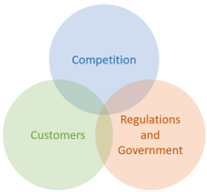I read somewhere that business is all about solving problems before someone else solves them for you. Certainly “Hope and Cope” is not a management strategy that has much going for it. Anticipation is everything, especially for business leaders in fast moving sectors like technology where it’s like driving at high speed. To correct a mantra that used to be much quoted: “move fast and don’t break things”.
As digital everything penetrates almost everywhere, Cloud is taking up its place as one of the three central resources of business, alongside cash and people. After working in Cloud for over ten years, I can honestly say that it’s in a very different place now from where we were then. That’s not surprising and it isn’t exactly news, but it shouts loud and clear that Cloud will not be in the same place tomorrow as it is today.
So it’s straightforward to conclude that decision makers need to have a view of the direction of Cloud if they want to anticipate and build these things into their thinking and planning. While there are always short-term factors, there are clear pressures and trends that are setting the course of Cloud over a three to five year horizon, which is what matters for business planning.
1. Customers are not in the Driving Seat
 The pressures on Cloud providers come chiefly from three directions: Competitors, Regulators and Government, and Customers.
The pressures on Cloud providers come chiefly from three directions: Competitors, Regulators and Government, and Customers.
As I’ve argued elsewhere, Cloud has been largely carved up by the two leading providers. Consequently, they and other providers, look principally at one another rather than to customers when they think about pricing and services. Amazon AWS and Microsoft Azure jostle with each other, and this influences what everyone else does and can do with whatever is left.
A key factor for providers is churn: customers leaving to go to another provider. The core functionalities of Cloud are commodities, and so providers do all sorts of things to make moving unattractive or worse for customers. The upshot of all this is that Customers are passengers, having to live with whatever services and pricing are on offer, with little direct or indirect influence over Cloud providers.
This situation seems certain to continue into the future. Services and pricing will change, and customers will just have to get on with it, whatever the future turns out to be. There’s no doubt that changes may prove to be disadvantageous, either through unfavourable price moves or unhelpful inflexibility. So business planners should be factoring this into their thinking as early as possible to make sure that their plans are not undermined by forces outside their control.
2. The Open Internet is Dead
 The early Internet was very much an American creation, deliberately de-centralised with a vision of openness that was distinctly Californian. This free and open environment is long gone and has given way to tripartite world that is driven by, arguable between, the EU, The USA and China.
The early Internet was very much an American creation, deliberately de-centralised with a vision of openness that was distinctly Californian. This free and open environment is long gone and has given way to tripartite world that is driven by, arguable between, the EU, The USA and China.
Data and data protectionism are the global geopolitical cannon fodder of the future. As argued by the recently published report by The Council on Foreign Relations: “Countries around the world now exert a greater degree of control over the internet, localizing data, blocking and moderating content, and launching political influence campaigns.”
We’ve seen EU regulation stealing a march with GDPR, and others having to fall into line. The US and EU are now each moving to regulate data more tightly in moves that look competitively driven in support of national, political interests. China, too, is moving to offset Western actions like the constraints on Huawei and favour its own interests and strengthen control over data.
Data is at the heart of all this, and these actions impact on the providers and users of Cloud and networks. There’s no sign of anything that could reverse the long-term direction of travel, which is towards ever tighter restrictions and constraints, all with a distinctly national, regional, and physically localised flavour. Decision makers should be taking this into account in planning, particularly those aspiring to build and operate internationally.
3. Performance is an unending hill climb
All aspects of computing have always been under pressure to perform, and decision makers should assume that this will always be true. Computers are never fast enough to respond; there’s an ever-growing lake of data to store and move from A to B; everyone is always trying to do more in different ways with greater efficiency.
Planners in technology based businesses must assume that these pressure will continue into the future, whatever they manage to achieve today and tomorrow. They may have to deliver new functionality not presently envisaged or deliver to new markets or devices in different circumstances, or perhaps all of the above at once. Change is inevitable and by and large we can assume it’s all going to be heading upwards.
In Cloud terms, this calls for the flexibility to be able to change quickly and easily, to adjust and exploit new opportunities and possibilities, and that puts the interests of customers firmly at odds with the interests of major Cloud providers, who are intent on keeping all customers, come what may.
New services, facilities, pricing and business models are becoming available all the time, but if you’re locked into one provider or architecture then you’re toast. Decision makers are wise to anticipate this and adopt strategies that enable them to navigate a path through this jungle.
4. The days of low prices are over
There is one last strategic factor that will shift the direction of Cloud, and it’s more about an era coming to a close that is causing the winds to shift direction, taking the Clouds with them. We’ve had a decade of cheap money, low inflation, and low costs of critical resources like people and electricity. This era has come to an end. Interest rates are rising aggressively, and inflationary cost rises are everywhere, are the indications are that these are going to be persistent.
Data centres gobble electricity, and so the cost of electricity is going to be a critical factor for Cloud users. One hospitality business I read about has just seen its annual energy costs rise by a factor of six, and a big hosting firm we know has had a four fold increase in its electricity costs in the last six months. This is now feeding through into Cloud prices.
Another cost factor is specialist people – they continue to be hard to recruit and even harder to retain, and that’s especially true of devs and DevOps engineers. We’re fortunate to have a large pool of expert specialists to deliver service to help our customers by running their infrastructure so that they can use their own precious tech team on more important projects.
Cloud businesses must avoid getting caught in the crossfire
Regulators and governments are tussling for supremacy with Big Tech. The EU is seeking to blunt the dominance of North American firms through regulation, and the US is responding. This shifting regulatory scene makes business planning hard to do with certainty, except to conclude that flexibility is essential.
National and regional governments are in a competitive struggle with one another, and data is the battleground. They seek to hobble one another, to give their own players a leg up, and often to control and have access to the data for their own political ends, which makes Cloud a difficult resource to deploy, particularly in an international context.
As if all that wasn’t enough, competitive actions by providers are overt and covert, and these actions make flexibility less straightforward to achieve, and can keep actual costs higher than they might otherwise be. These things add to the price pressures from energy and payroll.
Decision makers in Cloud based businesses must think ahead to ensure that they can respond in the future to the changes that are inevitable, and avoid getting caught in the battlefield crossfire on the way.
Peter is chairman of Flexiion and has a number of other business interests. (c) 2022, Peter Osborn
